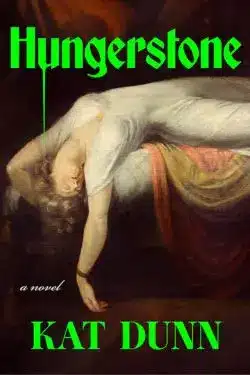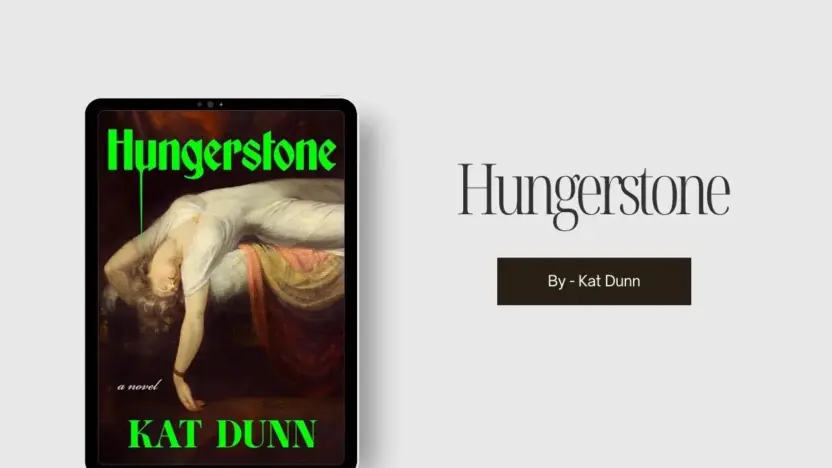Kat Dunn’s novel “Hungerstone” offers readers a captivating journey into a dark, gothic world where themes of desire, repression, and liberation intertwine. This reimagining of Sheridan Le Fanu’s classic “Carmilla” not only pays homage to its predecessor but also introduces fresh perspectives that resonate with contemporary audiences.
Plot Overview
Set against the backdrop of Victorian England’s industrial era, “Hungerstone” follows Lenore Crowther, an aristocratic woman trapped in a loveless marriage to Henry Crowther, a steel magnate. Their relocation to the secluded Nethershaw manor in Derbyshire marks the beginning of a series of unsettling events. Lenore’s life takes an unexpected turn when a mysterious carriage accident brings the enigmatic Carmilla Kernstein into their home. As Carmilla recuperates, Lenore finds herself irresistibly drawn to her, leading to a profound exploration of her own suppressed desires and the constraints imposed by society. Amidst this personal turmoil, young girls in nearby villages begin to fall ill under mysterious circumstances, adding a layer of suspense and horror to the narrative.
Atmospheric Setting and Gothic Elements
Dunn masterfully crafts a setting that is both haunting and immersive. The depiction of Nethershaw manor, surrounded by the desolate moorlands, evokes a sense of isolation and foreboding. This atmospheric backdrop enhances the novel’s gothic elements, creating a palpable tension that permeates the story. The contrast between the industrialized world of Sheffield and the wild, untamed nature of the Peak District serves to underscore the novel’s exploration of societal progress versus primal instincts.

Character Development
Lenore Crowther
At the heart of “Hungerstone” is Lenore’s transformative journey. Initially portrayed as the quintessential Victorian wife, adhering to societal expectations and suppressing her own needs, Lenore’s encounter with Carmilla acts as a catalyst for self-discovery. Her evolution from a passive figure to one who actively seeks autonomy and fulfillment is both compelling and relatable. This metamorphosis challenges traditional gender roles and highlights the enduring struggle for female empowerment.
Carmilla Kernstein
Carmilla embodies mystery and allure. Her presence disrupts the status quo, serving as both a liberator and a mirror to Lenore’s inner desires. Dunn’s portrayal of Carmilla is nuanced, presenting her neither as a mere antagonist nor a straightforward heroine, but rather as a complex character whose motivations and origins remain intriguingly ambiguous.
Themes and Symbolism
Hunger and Desire
The motif of hunger operates on multiple levels throughout the novel. It symbolizes not only physical appetite but also emotional and sexual yearning. Lenore’s suppressed desires manifest as a profound hunger, reflecting the broader theme of women’s repression in a patriarchal society. This metaphor extends to the vampiric elements of the story, where the act of feeding becomes an intimate and transgressive expression of desire.
Power and Control
“Hungerstone” delves into the dynamics of power, particularly in the context of marriage and societal structures. Henry’s dominance over Lenore exemplifies the gender imbalances of the time, while the burgeoning industrial landscape represents the relentless pursuit of control and progress, often at the expense of humanity and nature. Carmilla’s influence challenges these power structures, introducing chaos into the orderly world Henry has constructed.
Writing Style and Pacing
Dunn’s prose is richly descriptive, capturing the gothic essence without veering into melodrama. The deliberate pacing allows for a slow build-up of tension, mirroring Lenore’s gradual awakening and the escalating sense of dread that envelops Nethershaw. This methodical approach immerses readers in the period setting, making the eventual revelations and climactic moments all the more impactful.
Critical Reception
“Hungerstone” has garnered acclaim for its atmospheric storytelling and deep thematic exploration. Reviewers have lauded Dunn’s ability to intertwine gothic horror with feminist undertones, offering a fresh perspective on classic vampire lore. The novel’s intricate characterizations and evocative settings have been highlighted as standout elements that elevate the narrative.
Comparative Analysis
While “Hungerstone” draws inspiration from “Carmilla,” it distinguishes itself through its unique setting and thematic depth. The incorporation of industrial-era England adds a distinctive flavor, contrasting the raw, supernatural elements with the cold, mechanical world of industrialization. This juxtaposition enriches the narrative, offering readers a multifaceted exploration of desire, repression, and liberation.
Conclusion
Kat Dunn’s “Hungerstone” is a masterful blend of gothic horror and feminist literature. Through its atmospheric setting, complex characters, and profound themes, the novel invites readers to reflect on the nature of desire and the societal constructs that seek to suppress it.
Also Read: Summer in the City: By Alex Aster (Book Review)



